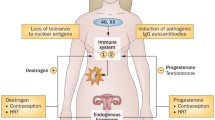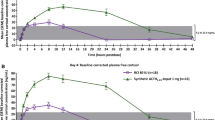Abstract
Our understanding of the immune system in health and disease has greatly increased over this past decade. An outgrowth of this burgeoning knowledge has been the discovery of novel strategies to treat a variety of autoimmune diseases. As a result, significant advances have been made in the treatment of arthritis with a half-dozen new treatments approved between September, 1998 and November, 1999. Although no new therapies have been approved for the treatment of systemic lupus erythematosus (SLE), this decade has witnessed an unprecedented amount of activity in drug development for this disease. This article specifically addresses the current status of drug development in the area of hormonal and biologic therapies for SLE.
Similar content being viewed by others
References and Recommended Reading
Derksen RHWM: Dehydroepiandrosterone (DHEA) and systemic lupus erythematosus. Semin Arthritis Rheum 1998, 27:335–347. This article is a comprehensive review of the pharmacology as well as the immunologic and clinical effects of DHEA.
Lahita RG, Cheng CY, Monder C, et al.: Experience with 19-nortestosterone in the therapy of systemic lupus erythematosus: worsened disease after treatment with 19-nortestosterone in men and lack of improvement in women. J Rheumatol 1992, 19:447–455.
Lucas JA, Ahmed SA, Casey ML, et al.: Prevention of autoantibody formation and prolonged survival in New Zealand black/New Zealand white F1 mice fed dehydroisoandrosterone. J Clin Invest 1985, 75:2091–2093.
Hedman M, Nilsson E, dela Torre B: Low sulpho-conjugated steroid hormone levels in systemic lupus erythematosus. Clin Exp Rheumatol 1989, 7:583–588.
Van Vollenhoven RF, Engleman EG, McGuire JL: An open study of dehydroepiandrosterone in systemic lupus erythematosus. Arthritis Rheum 1994, 37:1305–1310.
Van Vollenhoven RF, Engleman EG, McGuire JL: Dehydroepiandrosterone in systemic lupus erythematosus: results of a double-blind, placebo-controlled, randomized clinical trial. Arthritis Rheum 1995, 38:1826–1831.
Van Vollenhoven RF, Morabito LM, Engleman EG, et al.:Treatment of systemic lupus erythematosus with dehydroepiandrosterone: 50 patients treated up to 12 months. J Rheumatol 1998, 25(2):285–289. This article contains information on a relatively large group of patients with SLE treated with DHEA for 1 year.
Van Vollenhoven RF, Park JL, Genovese MC, et al.: A doubleblind, placebo-controlled clinical trial of dehydroepiandrosterone in severe systemic lupus erythematosus. Lupus 1999, 8:181–187l.
Petri M, Lahita R, McGuire J, et al.: Results of the GL701 (DHEA) multicenter steroid-sparing SLE study. Arthritis Rheum 1997, 40:S327.
Jones DS, Barstad PA, Feild MJ, et al.: Immunospecific reduction of antioligonucleotide antibody-forming cells with a tetrakis-oligonucleotide conjugate (LJP 394), a therapeutic candidate for the treatment of lupus nephritis. J Med Chem 1995, 38:2138–2144.
Coutts SM, Plunkett ML, Iverson GM, et al.: Pharmacologic intervention in antibody mediated disease. Lupus 1996, 5:158–159. This article serves as an introduction to the concept of clinical intervention with LJP 394, a unique B cell toleragen.
Weisman MH, Bluestein HG, Berner CM, et al.: Reduction in circulating dsDNA antibody titer after administration of LJP 394. J Rheumatol 1997, 24:314–318.
Hepburn B, Furie R, Cash J, et al.: Reduction of anti-DNA antibodies using LJP 394 in patients with lupus. Arthritis Rheum 1996, 39:S307.
Datta SK, Kalled SL. CD40-CD40 ligand interaction in autoimmune disease. Arthritis Rheum 1997, 40:1735–1745. This is a comprehensive review of the biology of CD40 and CD40L by leaders in the field. In vitro data is reviewed as is data in animal models of autoimmune disease.
Buhlmann JE, Noelle RJ: Therapeutic potential for blockade of the CD40 ligand, gp 39. J Clin Immunol 1996, 16:83–89.
Desai-Mehta A, Lu L, Ramsey-Goldman R, et al.: Hyperexpression of CD40 ligand by B and T cells in human lupus and its role in pathogenic autoantibody production. J Clin Invest 1996, 97:2063–2073. This article examines CD40L expression on mononuclear cells from patients with SLE. Effects of anti-CD40 ligand antibody on DNA autoantibody production are described.
Kato KK, Santana-Sahagun E, Rassenti LZ, et al.: The soluble CD40 ligand sCD154 in systemic lupus erythematosus. J Clin Invest 1999, 1047:947–955.
Yellin MJ, D’Agati V, Parkinson G, et al.: Immunohistologic analysis of renal CD40 and CD40L expression in lupus nephritis and other glomerulonephritides. Arthritis Rheum 1997, 40:124–134. This article addresses the role of CD40 and CD40L in human lupus nephritis.
Kalled SL, Cutler AH, Datta SK, et al.: Anti-CD40 ligand antibody treatment of SNF1 mice with established nephritis; preservation of kidney function. J Immunol 1998, 160:2158–2165. This is one in a series of articles that documents favorable outcomes in lupus-prone mice after treatment with anti-CD40 ligand antibody.
Early GS, Zhao W, Burns CM: Anti-CD40 ligand antibody treatment prevents the development of lupus-like nephritis in a subset of New Zealand black x New Zealand white mice. J Immunol 1996, 3159–3164.
Davis JC, Totoritis M, Sklenar T, et al.: Results of a phase I, single-dose, dose-escalating trial of a humanized monoclonal anti-CD40L antibody (IDEC-131) in patients with systemic lupus erythematosus (SLE). Arthritis Rheum 1999, 42:S281.
Bussel J, Wissert M, Oates B, et al. Humanized monoclonal anti-CD40 ligand antibody rescue therapy of 15 adults with severe chronic refractory ITP [abstract]. Blood 1999,10:646.
George J, Raskob G, Bussel J, et al. Safety and effect of platelet count of repeated doses of monoclonal antibody to CD40 ligand in patients with chronic ITP [abstract].Blood 1999,10:19.
Porcel JM, Ordi J, Castro-Salomo A, et al.: The value of complement activation products in the assessment of systemic lupus erythematosus flares. Clin Immunol Immunopathol 1995, 74:283–288. This is one of several articles that discusses the value of complement activation products in assessing lupus activity.
Wang Y, Hu Q, Madri JA, et al.: Amelioration of lupus-like autoimmune disease in NZB/W F1 mice after treatment with a blocking monoclonal antibody specific for complement component C5. Proc Natl Acad Sci USA 1996, 93:8563–8568. This article documents a significant effect on the course of lupusprone mice when C5 activation is blocked with a monoclonal antibody to C5.
Jain RI, Moreland LW, Caldwell JR, et al.: A single dose, placebo controlled, double blind, phase I study of the humanized anti-C5 antibody h5G1.1 in patients with rheumatoid arthritis. Arthritis Rheum 1999, 42:S77.
Schneider M, Berning T, Waldendorf M, et al.: Immunoadsorbent plasma perfusion in patients with systemic lupus erythematosus. J Rheumatol 1990, 17:900–907.
Funauchi M, Ikoma S, Enomoto H, et al.: High-affinity anti-DNA antibody parallels clinical course of immunoadsorption therapy for systemic lupus erythematosus. Intern Med 1996, 35:367–372.
Silvestris F, D’Amore O, Cafforio P, et al.: Intravenous immune globulin therapy of lupus nephritis: use of pathogenic anti-DNA-reactive IgG. Clin Exp Immunol 1996, 104:91–97.
Lee ML, Spertini F, Leimgruber A: Updated phase I clinical results with an idiotypic vaccine (3E10) for systemic lupus erythematosus (SLE). Arthritis Rheum 1995, 8:S303.
Davis JC, Manzi S, Yarboro C, et al.: Recombinant human DNase I (rhDNase) in patients with lupus nephritis. Lupus 1999, 8:68–76.
Hiepe F, Pfuller B, Wolbart K, et al.: C1q: a multifunctional ligand for a new immunoadsorption treatment. Ther Apher 1999, 3:246–251.
Park YB, Lee SK, Kim DS, et al.: Elevated interleukin-10 levels correlated with disease activity in systemic lupus erythematosus. Clin Exp Rheumatol 1998, 16:283–288.
Llorente L, Garcìa-Padilla C, Richaud-Patin Y, et al.: Treatment of systemic lupus erythematosus with an anti-interleukin-10 monoclonal antibody. Arthritis Rheum 1998, 41:S109.
Abrams JR, Lebwohl MG, Guzzo CA, et al.: CTLA4Ig-mediated blockade of T-cell costimulation in patients with psoriasis vulgaris. J Clin Invest 1999, 103:1243–1252.
Finck BK, Linsley PS, Wofsy D: Treatment of murine lupus with CTLA4Ig. Science 1994, 265:1225–1227. This article documents treatment response in a model of murine lupus through blockade of a costimulatory pathway.
Cunnane G, Ben Y, Cassafer G, et al.: Effects of combined CTLA4Ig and cyclophosphamide on renal pathology in advanced murine lupus. Arthritis Rheum 1999, 42:S359.
Strand V: Biologic agents and innovative interventional treatments in the management of systemic lupus erythematosus. Curr Opin Rheumatol 1999, 11:330–340. This article is a very comprehensive review of all therapies in trial for SLE.
Brooks EB, Liang MH: Evaluation of recent clinical trials in lupus. Curr Opin Rheumatol 1999, 11:341–347. This article analyzes trial design in SLE and utilizes recent trials as examples.
Author information
Authors and Affiliations
Rights and permissions
About this article
Cite this article
Furie, R. Dehydroepiandrosterone and biologics in the treatment of systemic lupus erythematosus. Curr Rheumatol Rep 2, 44–50 (2000). https://doi.org/10.1007/s11926-996-0068-5
Issue Date:
DOI: https://doi.org/10.1007/s11926-996-0068-5




